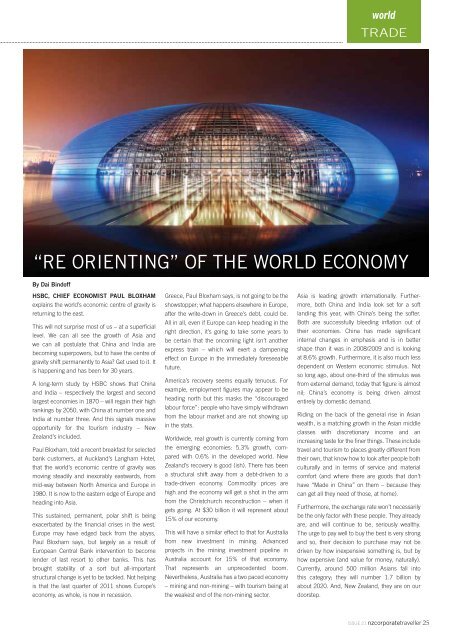Issue 21 2012.pdf - New Zealand Corporate Traveller Magazine
Issue 21 2012.pdf - New Zealand Corporate Traveller Magazine
Issue 21 2012.pdf - New Zealand Corporate Traveller Magazine
Create successful ePaper yourself
Turn your PDF publications into a flip-book with our unique Google optimized e-Paper software.
HSBC, CHIEF ECONOMIST PAUL BLOXHAM<br />
explains the world’s economic centre of gravity is<br />
returning to the east.<br />
This will not surprise most of us – at a superfi cial<br />
level. We can all see the growth of Asia and<br />
we can all postulate that China and India are<br />
becoming superpowers, but to have the centre of<br />
gravity shift permanently to Asia? Get used to it. It<br />
is happening and has been for 30 years.<br />
A long-term study by HSBC shows that China<br />
and India – respectively the largest and second<br />
largest economies in 1870 – will regain their high<br />
rankings by 2050, with China at number one and<br />
India at number three. And this signals massive<br />
opportunity for the tourism industry – <strong>New</strong><br />
<strong>Zealand</strong>’s included.<br />
Paul Bloxham, told a recent breakfast for selected<br />
bank customers, at Auckland’s Langham Hotel,<br />
that the world’s economic centre of gravity was<br />
moving steadily and inexorably eastwards, from<br />
mid-way between North America and Europe in<br />
1980. It is now to the eastern edge of Europe and<br />
heading into Asia.<br />
This sustained, permanent, polar shift is being<br />
exacerbated by the fi nancial crises in the west.<br />
Europe may have edged back from the abyss,<br />
Paul Bloxham says, but largely as a result of<br />
European Central Bank intervention to become<br />
lender of last resort to other banks. This has<br />
brought stability of a sort but all-important<br />
structural change is yet to be tackled. Not helping<br />
is that the last quarter of 2011 shows Europe’s<br />
economy, as whole, is now in recession.<br />
Greece, Paul Bloxham says, is not going to be the<br />
showstopper; what happens elsewhere in Europe,<br />
after the write-down in Greece’s debt, could be.<br />
All in all, even if Europe can keep heading in the<br />
right direction, it’s going to take some years to<br />
be certain that the oncoming light isn’t another<br />
express train – which will exert a dampening<br />
effect on Europe in the immediately foreseeable<br />
future.<br />
America’s recovery seems equally tenuous. For<br />
example, employment fi gures may appear to be<br />
heading north but this masks the “discouraged<br />
labour force”: people who have simply withdrawn<br />
from the labour market and are not showing up<br />
in the stats.<br />
Worldwide, real growth is currently coming from<br />
the emerging economies: 5.3% growth, compared<br />
with 0.6% in the developed world. <strong>New</strong><br />
<strong>Zealand</strong>’s recovery is good (ish). There has been<br />
a structural shift away from a debt-driven to a<br />
trade-driven economy. Commodity prices are<br />
high and the economy will get a shot in the arm<br />
from the Christchurch reconstruction – when it<br />
gets going. At $30 billion it will represent about<br />
15% of our economy.<br />
This will have a similar effect to that for Australia<br />
from new investment in mining. Advanced<br />
projects in the mining investment pipeline in<br />
Australia account for 15% of that economy.<br />
That represents an unprecedented boom.<br />
Nevertheless, Australia has a two paced economy<br />
– mining and non-mining – with tourism being at<br />
the weakest end of the non-mining sector.<br />
world<br />
TRADE<br />
“RE ORIENTING” OF THE WORLD ECONOMY<br />
By Dai Bindoff<br />
Asia is leading growth internationally. Furthermore,<br />
both China and India look set for a soft<br />
landing this year, with China’s being the softer.<br />
Both are successfully bleeding infl ation out of<br />
their economies. China has made signifi cant<br />
internal changes in emphasis and is in better<br />
shape than it was in 2008/2009 and is looking<br />
at 8.6% growth. Furthermore, it is also much less<br />
dependent on Western economic stimulus. Not<br />
so long ago, about one-third of the stimulus was<br />
from external demand, today that fi gure is almost<br />
nil; China’s economy is being driven almost<br />
entirely by domestic demand.<br />
Riding on the back of the general rise in Asian<br />
wealth, is a matching growth in the Asian middle<br />
classes with discretionary income and an<br />
increasing taste for the fi ner things. These include<br />
travel and tourism to places greatly different from<br />
their own, that know how to look after people both<br />
culturally and in terms of service and material<br />
comfort (and where there are goods that don’t<br />
have “Made in China” on them – because they<br />
can get all they need of those, at home).<br />
Furthermore, the exchange rate won’t necessarily<br />
be the only factor with these people. They already<br />
are, and will continue to be, seriously wealthy.<br />
The urge to pay well to buy the best is very strong<br />
and so, their decision to purchase may not be<br />
driven by how inexpensive something is, but by<br />
how expensive (and value for money, naturally).<br />
Currently, around 500 million Asians fall into<br />
this category; they will number 1.7 billion by<br />
about 2020. And, <strong>New</strong> <strong>Zealand</strong>, they are on our<br />
doorstep.<br />
ISSUE <strong>21</strong> nzcorporatetraveller 25



